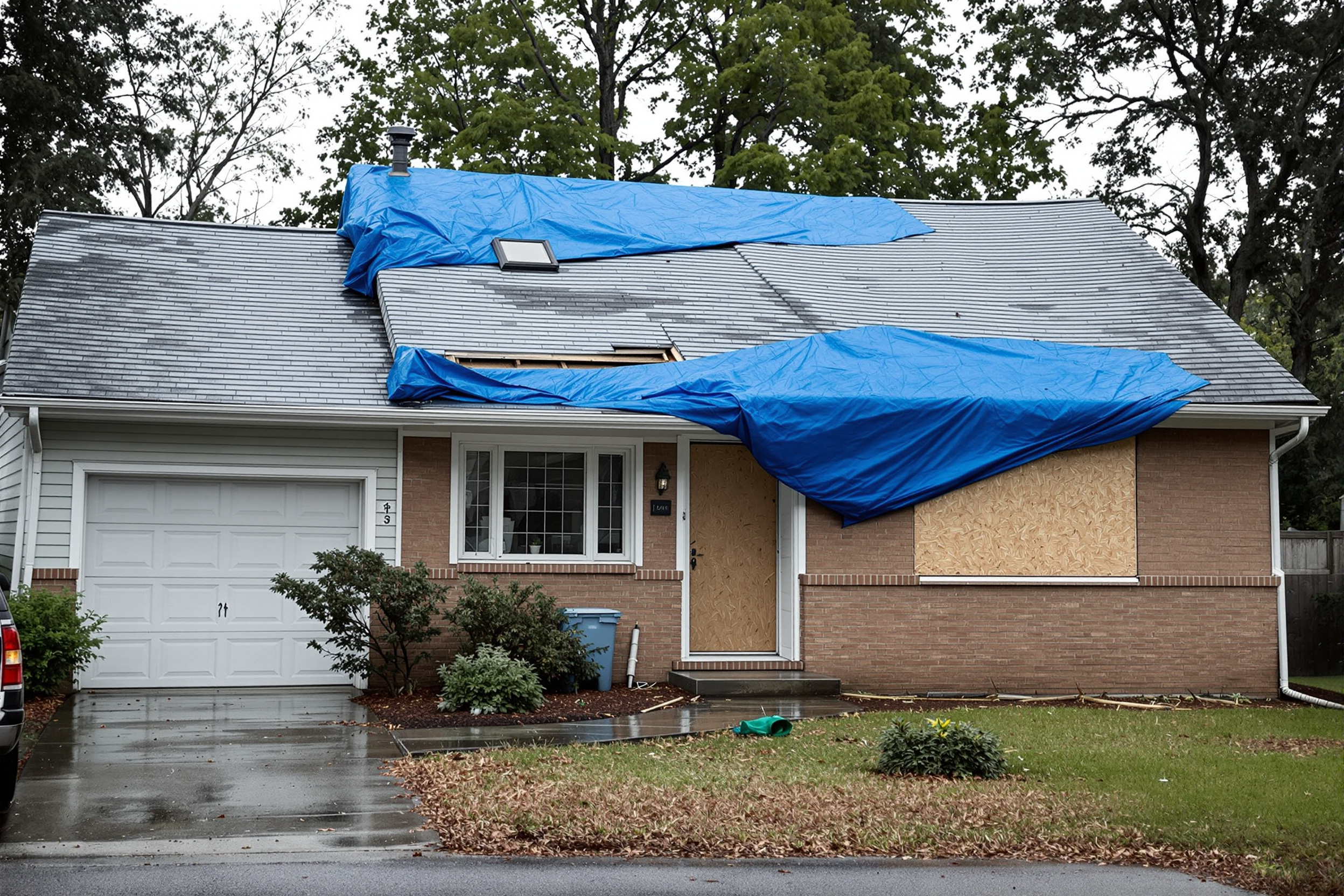Landlord insurance covers loss of rental income. Think of it as your financial safety net when your property becomes unlivable after a covered disaster, like a fire or a severe typhoon. It replaces your lost monthly income so you can still pay your bills during repairs.
This guide will explain exactly what events are covered by insurance on a rental property, what’s excluded, and how to ensure your policy truly protects your investment.
What is Loss of Rental Income Insurance?
Loss of rental income insurance, also known as rent loss insurance or fair rental value coverage, replaces the rent payments you lose when your property cannot be lived in due to damage from a covered event, like a fire or hurricane.
This coverage is usually included in a landlord insurance policy or added as an endorsement. If a covered peril makes the home unlivable during repairs, the insurer reimburses the rent you would have collected. You can use that money to keep paying ongoing bills, such as:
- Mortgage and loan interest
- Property taxes
- HOA or condo dues
- Utilities you cover for the unit
- Property management fees
When Does Loss of Rental Income Insurance Provide Coverage?
If you experience a loss of rental income due to an insured peril, loss of rental income insurance can replace any rent payments you’re unable to collect.
Covered perils vary depending on the type of landlord insurance policy you obtain. For example, DP1 is a named peril policy that typically provides coverage in the event of:
- Fire
- Lightning
- Smoke
- Explosions
- Windstorms and hailstorms
- Vehicles
- Aircraft
- Riots or civil commotion
- Volcanic explosions
Therefore, if you have a DP1 policy and your property becomes uninhabitable due to one of the above perils, you may be able to file a claim for lost rental income.
Loss of rent is typically covered until repairs are complete or a maximum of 12 months—whichever amount of time is shortest. You can also usually collect on this type of loss of income insurance coverage whether there was an existing tenant on the property or not.
What Isn’t Covered by Loss of Rental Income Insurance?
This coverage is for physical casualty loss on rental property, not business risks or tenant issues. Here are common situations where this landlord insurance for loss of rent typically will not help:
- Tenant Non-Payment: If your tenant is able to live in the property but simply stops paying rent, this is not covered. You would need a separate policy, often called "rent guarantee insurance," if you want insurance to cover rent payments in that situation.
- Normal Vacancy: The time your property sits empty while you search for a new tenant is a normal part of the rental business and is not covered.
- Excluded Perils: Standard policies almost always exclude damage from floods and earthquakes. To be covered for these events, you must buy separate, specific insurance policies.
- Utility Failure: If a neighborhood-wide power outage makes the home unlivable, this coverage won't apply because there is no direct physical damage to your property.
How Does Rent Loss Insurance Coverage Work?
Once the policy’s waiting period ends, the insurer pays the rent you would have collected, up to your limit, until repairs restore habitability or the maximum indemnity period expires.
- Covered loss occurs: Damage from a named peril forces tenants to move out.
- Waiting period applies: Most policies include a short deductible period, often forty‑eight to seventy‑two hours, before payments begin.
- Verify lost income: Provide lease agreements, recent bank statements, and proof of consistent rent collection.
- Insurer calculates payout: The company compares documented rent with your policy limit and applies any coinsurance clause.
- Payments issued: Reimbursements follow your normal rent schedule, either monthly or as a lump sum.
- Coverage ends: Benefits stop when the unit is habitable again or when you reach the policy’s time or dollar cap, whichever comes first.
Rent loss insurance keeps your cash flow steady, helping you cover mortgage payments, taxes, and maintenance without tapping into reserves.
How Much Rent Loss Insurance Coverage Do You Need?
Choosing the right coverage amount is a critical balancing act of rental property profit and loss. You want enough to be fully protected if a disaster happens, but you don't want to overpay for insurance you'll never use. Figuring out the right number is simpler than you might think.
The best way to estimate your need for lost income insurance coverage is with a straightforward formula.
Your Gross Monthly Rent x 12 Months = Your Recommended Coverage Amount
Let's break down why this formula works so well.
1. Start with Your Gross Monthly Rent
First, look at your "gross" rent. This is the total amount of rent you collect each month before you pay your mortgage, property taxes, or other expenses.
If your tenant pays you $1,500 a month, that is your gross monthly rent. You use this number because your insurance is meant to replace that entire income stream, which you then use to pay your bills.
2. Use the 12-Month Coverage Period
Why 12 months? While a minor repair might only take a couple of months, a major event like a fire or severe storm could take much longer to fix. You have to account for time to find good contractors, get the right building permits, and deal with any unexpected delays.
A 12-month period for your loss of rent insurance is widely considered the safest option. It provides a strong financial cushion to handle a worst-case scenario without stress.
Putting It All Together: A Simple Example of How Much Rent Loss Insurance Coverage Do You Need
Let's see the formula in action:
- Your gross monthly rent is: $1,500
- The recommended safe coverage period is: 12 months
- Your calculation is: $1,500 x 12 = $18,000
In this example, you should make sure your policy includes at least $18,000 in loss of rents coverage.
A final tip: Review your policy annually. As rents in your area go up, so should your coverage. Your insurance agent can help you adjust your rental income insurance coverage to make sure it always matches your property's value.
How to Claim Loss of Rental Income
When you need to make a claim for loss of rent landlord insurance, a clear process reduces stress. Follow these five key steps to file a successful claim for your lost rent.
Quick Steps for Your Claim:
- Contact your insurer immediately.
- Document all damage with photos and videos.
- Prevent further damage from occurring.
- Gather your lease and proof of rent payments.
- Cooperate with the insurance adjuster.
Here is a more detailed look at each step:
1. Contact Your Insurer
Call your insurance agent or the company's claims hotline as soon as it is safe. Give them your policy number to start the process quickly. The sooner they know, the faster they can act.
2. Document All Damage
Before you move or clean anything, use your phone to take many clear photos and videos of the damage. This visual record is your most powerful proof for the claim.
3. Prevent Further Damage
Your policy requires you to take reasonable steps to stop the damage from getting worse. This could mean placing a tarp over a damaged roof or shutting off a leaking water pipe. Remember to keep your receipts for any supplies you purchase for these temporary fixes.
4. Gather Proof of Income
You must prove the amount of rent you have lost. Prepare a copy of the current signed lease agreement and records of past rent payments, like bank statements. This shows exactly how much income your rent loss insurance needs to replace.
5. Cooperate with the Adjuster
Your insurance company will assign an adjuster to review your claim. Their job is to assess the damage and the value of the loss. Provide them with all your documents and keep simple notes of your conversations.
Insurance Built for Investors, Not Just Homeowners
Traditional insurance wasn't designed for the speed and strategy of modern real estate investing.
At Obie, we focus exclusively on providing insurance for landlords like you. We understand that protecting your cash flow with robust loss of rent coverage is just as critical as protecting the building itself.
Our platform makes it simple to get a transparent, comprehensive quote in minutes. Stop settling for one-size-fits-all coverage and get the specific protection your investment truly deserves.
See your instant quote from Obie now.
FAQs about Loss of Income Insurance
Does landlord insurance automatically include loss of rent insurance?
Standard landlord policies often exclude income loss unless you add a specific loss of rents endorsement.
Can I claim loss of rent if a kitchen fire affects only one unit in a duplex?
Yes, if the lease and adjuster confirm the damaged unit is uninhabitable, coverage applies to that unit’s rent.
What documents prove lost income?
Signed leases, bank statements, rent receipts, and property management reports.
How long do payments last?
Most policies cap benefits at twelve months or the stated dollar limit, whichever you hit first.
Is loss of rental income insurance tax‑deductible?
Premiums are an ordinary business expense, so you can deduct them on Schedule E.







